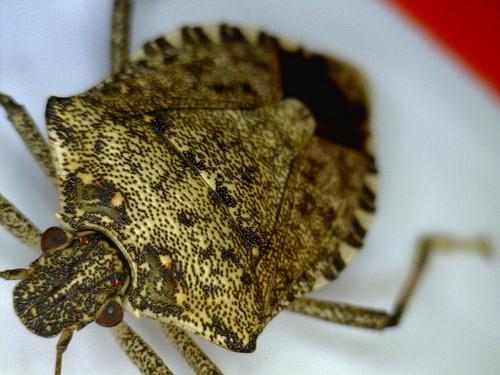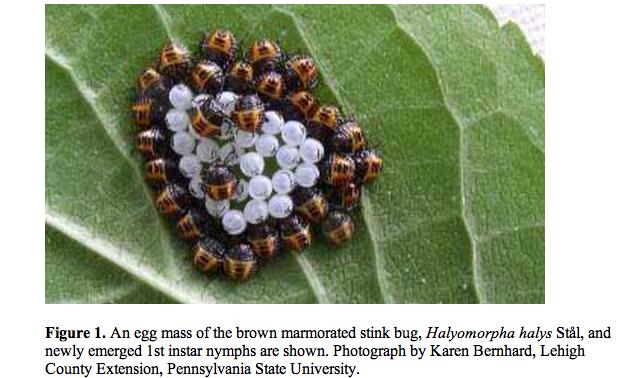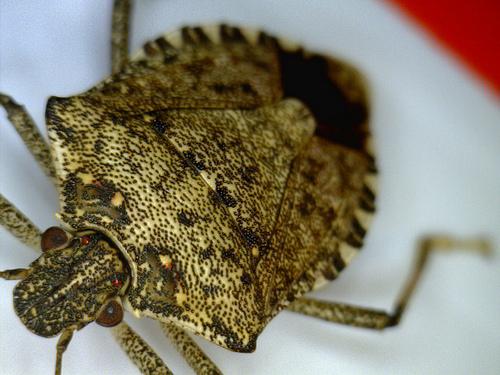When J.D. Rinehart noticed brownish, depressed areas on his orchards’ apples and peaches about five years ago, he thought the fruit was low in calcium. But spraying the fruit with calcium didn’t help.
When University of Maryland researchers cut open his fruit and examined it, it became clear that the problem was much more damaging and unpredictable: stink bugs.
Rinehart, owner of Rinehart Orchards in Washington County, said stink bugs damage 10 to 20 percent of his crop every year.

Adult Brown Marmorated Stink Bug, Photo by: Mike Lewinski
“They are a major, major issue in our orchards. It has really changed our approach to managing our applications of pesticides,” Rinehart said. “It’s nothing that you can take lightly.”
Damage caused by the Brown Marmorated Stink Bug, an invasive species introduced to North America in the late 1990s, was particularly severe in 2010 and 2011. Some Maryland growers like Rinehart are still dealing with stink bug-related damage, which, he said, can decrease the worth of a fruit by 90 percent. But others have seen damage subside.
Although damage to crops — inflicted when stink bugs pierce fruit with their mouths and suck sugar out — has decreased since 2010 and 2011, there’s no reason to believe the insect is in any permanent state of decline, said Gerry Brust, a state integrated pest management vegetable specialist for University of Maryland Extension.
“That’s what insect populations do. It goes up, down,” he said.
 Even relatively extreme environmental conditions, such as the record low temperatures the polar vortex brought to many parts of the nation this month, are not enough to cause any long-term decline in the state’s stink bug population.
Even relatively extreme environmental conditions, such as the record low temperatures the polar vortex brought to many parts of the nation this month, are not enough to cause any long-term decline in the state’s stink bug population.
Stink bugs can escape cold conditions by living in dead or rotting trees, rock outcroppings or buildings, said Donald Weber, a research entomologist for the U.S. Department of Agriculture.
“They’re perfectly capable of surviving the winter,” Weber said. “A lot of them are in pretty sheltered areas, so they’re well equipped to survive even the recent cold snap that we had.”
The insects have not just survived, though; they have expanded to more than 40 states, as well as parts of Canada and Europe, Weber said.
According to a team of researchers funded by the USDA’s Specialty Crop Research Initiative, Maryland and every state it shares a border with, plus New Jersey, are the only ones in which “severe agricultural and nuisance problems” related to stink bugs have been reported.
Rinehart said he has to aggressively scout for stink bug damage. If he finds significant damage, he can spray a repellant, which is safe for the produce but also repels beneficial insects. Pesticides are only a short-term solution, Weber said.
Guy Moore, of Howard County’s Larriland Farm, said that stink bugs brought devastating damage in 2010 and 2011 but did not not cause significant damage in subsequent years.
USDA researchers take samples of apples and peaches from his farm and have been able to help monitor the stink bug population and detect damage. Moore hopes the stink bugs will only be a nuisance in the future.
University of Maryland Extension personnel from Cecil, Dorchester, Montgomery and Washington counties said each county has experienced periods of bad damage, but they have come at different times: fall 2013 in Central Maryland, 2011 in Dorchester County and across the state in 2010 and 2011.
Stink bugs have been in North America for a relatively brief period of time, so researchers still do not know much about their population dynamics, Weber said.
“We’ve only had a few years; there’s a lot of other things that can happen,” he said. “We had a big cold snap this year; maybe that does nothing to them. We just don’t know. The safe bet is they’re not going away, and they’re going to be a distinct and significant pest problem in the mid-Atlantic states for a while.”
Some existing predators are slowly starting to recognize stink bugs as potential prey, Weber said. Researchers are considering introducing natural enemies to feed on the non-native stink bugs.
Identifying and deploying natural enemies could take a long time. Introducing a stink bug predator could take three to five years and would require the approval of scientists from all three North American countries, Weber said.
There will likely be a proposal to introduce tiny wasps as predators of stink bugs within a year, Weber said. The wasps lay their eggs on other insects’ eggs, allowing the newly hatched wasps to eat the eggs of their prey — including stink bugs.
Organic chemists have also synthesized the stink bug’s pheromone and are working on commercializing it, Weber said. The pheromone could allow growers to draw the insects away from produce.
Until researchers — or nature — develop reliable means to keep stink bug populations under control, Maryland growers will have to continue to use short-term measures to minimize damage.
“In this business, you are at the mercy of nature. Stink bugs are something that have definitely added to that and added in a very strong way,” Rinehart said. “Yeah, stink bugs are a bummer, man.”
..



Write a Letter to the Editor on this Article
We encourage readers to offer their point of view on this article by submitting the following form. Editing is sometimes necessary and is done at the discretion of the editorial staff.